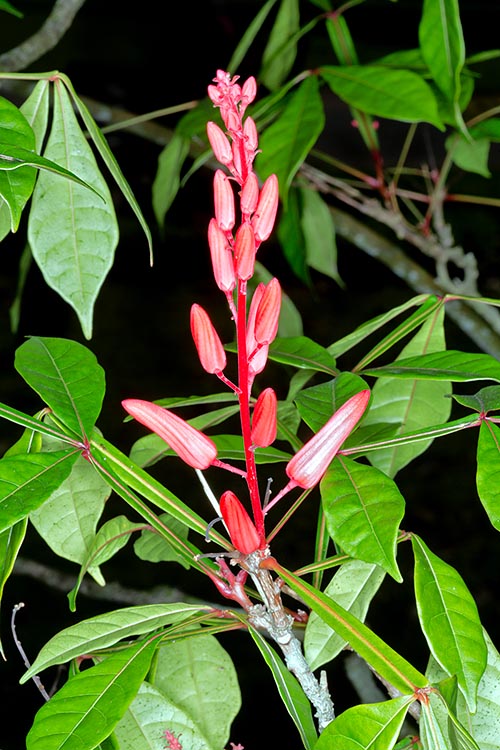Family : Simaroubaceae

Text © Pietro Puccio

English translation by Mario Beltramini

Quassia amara is a tropical evergreen reaching 2-6 m. Drinks flavouring with medicinal virtues, repellent and insecticide, eco-friendly © Giuseppe Mazza
The genus is honoured to a slave of Surinam (the former Dutch Guyana), Quassi, who discovered its medicinal properties in the XVIII century; the name of the species is the Latin adjective “amarus, a, um” = bitter, with reference to the particularly bitterish taste of the wood, the bark and the root.
Common names: bitter ash, bitterwood, quassia, quassia-wood, Surinam quassia (English); bois amer, bois blanc, quassia de Surinam, quinine de Cayenne, quinine du pays (French); china di Caienna, legno amaro, legno quassio del Suriname (Italian); amargo, marubà, marupà, pau-amarelo, pau-quassia, quassia-de-caiena, quina, quinarana (Portuguese-Brazil); crucete, cuasia amarga, cuasia de Jamaica, cuasia de Surinam, guabito, guabito amargo, hombre grande (Spanish); Bitterholzbaum, Bitterquassia, Quassiaholzbaum (German).
The Quassia amara L. (1762) is a shrub or an evergreen tree up to 2-6 m tall with smooth greyish bark and alternate leaves, 15-30 cm long, imparipinnate, with winged petiole and rachis and 3-5 sessile leaflets, ovate-lanceolate with pointed apex, thinned base and entire margin, of intense green colour above, pale below and reddish central nervation, 5-16 cm long and 3-6 cm broad. Terminal racemose inflorescences, with reddish peduncle and rachis, carrying several hermaphroditic flowers, on a pink, 1-4 cm long, pedicel, with a 2,5-4,5 cm long tubular corolla having 5 linear-lanceolate bright red or pinkish externally, white inside, petals, and 10 prominent stamina with yellow anthers; the flowers are mainly pollinated by the humming birds. The fruits, usually 4-5 on a wide red receptacle, are ovoid drupes initially green, then black when ripe, 1-1,5 cm long.
It reproduces by seed, which is to be interred in short time having low germinability duration, 1-2 months, using a sandy loam maintained humid at the temperature of 24-26 °C, and by semi-woody cutting and by air layering. Species of remarkable ornamental effect due to the foliage as well as to the inflorescences, cultivable exclusively in the humid tropical and subtropical climate zones in full sun or slight shade on fertile soils, well drained and permanently humid but without stagnations; suitable, thanks to its contained size, also for small gardens. Elsewhere, it may be cultivated in capacious containers in luminous greenhouses using an organic loam with addition of coarse siliceous sand or agri-perlite per a 30%, to improve the drainage, with lowest winter temperatures not under the 15 °C.
The pale yellow wood contains various active principles, the main of them being the quassin, particularly bitter, that are extracted from the crushed wood. Extracts used in the past in the traditional medicine especially as antipyretics and antimalarials, have presently a moderate employment as flavourings of alcoholic and non-alcoholic drinks, within maximum values established by the various countries, and as insecticides and natural repellents in agriculture, against aphids, scale insects, tenthredins and thrips, with toxic action lower than that of pyrethrum, but with the advantage of not being, at the utilized dosages, phytotoxic and harmful for mammals, bees and other useful insects.
Synonyms: Quassia amara var. paniculata Engl. (1874); Quassia amara f. paniculata (Engl.) Cronquist (1944).
→ To appreciate the biodiversity within the SIMAROUBACEAE family please click here.
